



Suggested citation: Mallya, Hemant, Sankalp Kumar, and Sabarish Elango. 2024. Assessing Effectiveness of India’s Industrial Emission Monitoring Systems. New Delhi: Council on Energy, Environment and Water.
Indian industries contribute around 30 per cent to India’s particulate matter pollution. Urgent measures are needed to improve monitoring and compliance to keep industrial pollution in check as the economy continues growing. Continuous emission monitoring systems (CEMS) can bridge this compliance gap. CEMS are devices that measure pollutant concentrations and flow in industrial chimney stacks and relay this information at frequent intervals to the state and central pollution control boards (SPCBs and CPCBs). The CPCB’s guidelines (issued in 2014, 2017, and 2018) and the Supreme Court’s ruling (in 2017) have mandated the installation of online CEMS (OCEMS) in various highly polluting industries and the public availability of the CEMS data in online portals maintained by each SPCB. However, there has been no change in the relevant acts and regulations to make CEMS data legally admissible, i.e., there is no mandate to allow the SPCBs or the CPCBs to issue non-compliance notices to industries on the basis of CEMS data.
This study, as part of the USAID-supported Cleaner Air and Better Health (CABH) project, analyses the public accessibility and quality of the CEMS data relayed by various state OCEMS portals. It makes recommendations for consolidating CEMS regulations and providing legal sanctity to CEMS data. The study ranks 20 publicly accessible OCEMS portals (out of 32 states/UTs requiring CEMS to be installed as of 31 December 2021) for ease of public access and transparency. The study also evaluates the quality of CEMS data relayed by six states and six industry types in 2019 and 2020. The data quality was evaluated on the basis of number of hours of data availability over each year, frequency of missing data, and compliance to guidelines on different emission parameters to be monitored. The study also makes recommendations regarding integrating ambient air quality monitors within industrial facilities into the national network for more accurate air quality monitoring.
Almost every Indian is impacted by polluted air. The Air Quality Life Index (AQLI 2023) reported that India faces the greatest health burden from air pollution due to the large number of people in heavily polluted areas. The average emissions of particulate matter with a diameter of 2.5 microns or less (PM2.5) in India are more than 10 times the permissible limits set by the World Health Organization. Of the various sources that are contributing to India’s worsening air pollution crisis, the industrial sector is one of the largest — contributing 23–37 per cent of PM10 and 21–38 per cent of PM2.5 emissions (Ganguly, Khan, and Ganesan 2021).
Urgent measures are needed to improve the monitoring and regulation of industrial emissions, failing which air pollution from this rapidly growing sector will keep increasing. Data transparency in this regard is also essential. There have been several interventions by the national and state governments and regulatory agencies that aim to curb industrial air pollution. Currently, the only legally approved method for monitoring industrial emissions is periodic manual measurements. However, in 2014, the Central Pollution Control Board (CPCB) directed 17 highly polluting industries to install continuous emission monitoring systems (CEMS) at their facilities (CPCB 2014) to measure pollutant and process parameters, while still retaining the manual method as the legally approved method. The guidelines for installing CEMS and monitoring pollutants are provided in the “1st Revised Guidelines for Continuous Emission Monitoring Systems, August 2018,” hereinafter referred to as the Guidelines (CPCB 2018).
The Supreme Court, in 2017, directed every state and union territory of the country to display CEMS data on the publicly accessible online CEMS (OCEMS) web portals of the State Pollution Control Boards (SPCBs) and Pollution Control Committees (PCCs) by August 2017. Following the judgment, the CPCB issued closure or show-cause notices to 1,033 industries that either did not install CEMS or did not provide the CEMS data because of a lack of connectivity to the CPCB server (CPCB 2017a). The CPCB and SPCBs have made concerted efforts to instil a culture of self-monitoring and regulation in industries. Providing legal sanctity to CEMS will go a long way in supporting these initiatives by pollution control boards.
Although data from industrial CEMS has been collected since 2014, there has been no detailed independent assessment on the data availability and accessibility. This assessment of the data available (as of 31 December 2021) on the OCEMS web portals of all 35 SPCBs/PCCs indicates that there is substantial room for strengthening monitoring and compliance. The objective in this assessment is to evaluate the ease of accessing and interpreting the data made available on the OCEMS web portals. The data availability and pollutant monitoring compliance of the CEMS that are relaying data to the OCEMS portal were also evaluated. Increased transparency is critical to dispel concerns about the reliability of data and non-compliance, identify violators, generate public awareness, and fulfil the overall objectives of CEMS deployment; it would also act as a deterrent because the industry would not like to be seen in a negative light.
The analysis and findings are based on
Among the 35 SPCBs/PCCs, 3 have no industry requiring OCEMS connectivity (CPCB 2020b). Of the remaining 32, only 11 have OCEMS web portals that provide 30 days or more of historical data. This makes it impossible to identify solely based on publicly available data those facilities in 20 states and union territories that do not comply with CPCB emission standards.
Additionally, it was found that the OCEMS web portals of the states with more industrial facilities are less accessible than those of less-industrialised states. Tamil Nadu, Gujarat, and Andhra Pradesh have publicly accessible OCEMS web portals, but none of the web portals provides access to historical data or an option to download data (as of 31 December 2021). There are also significant variations in the amount of data made available on the portals and the ease with which this data can be accessed and interpreted. Figure ES 1 shows the availability and accessibility of OCEMS data.
19 OCEMS web portals were scored and ranked on seven parameters (Odisha’s web portal was unavailable as of 31 December 2021); Rajasthan has upgraded its portal in June 2022 and has more information than when this analysis was completed, which is not represented in this report. Chhatisgarh also updated its portal for easier accessibility. The highest score indicates the best portal overall from the perspective of ease-of-use and utility.
Key findings across parameters:
The Madhya Pradesh and Himachal Pradesh OCEMS web portals were the most comprehensive, obtaining full scores in 6 out of 7 parameters, among the 19 portals evaluated. The only feature lacking in these portals is geotagging.
Figure ES1 Only 20 states have public OCEMS portals, with 9 providing historical data
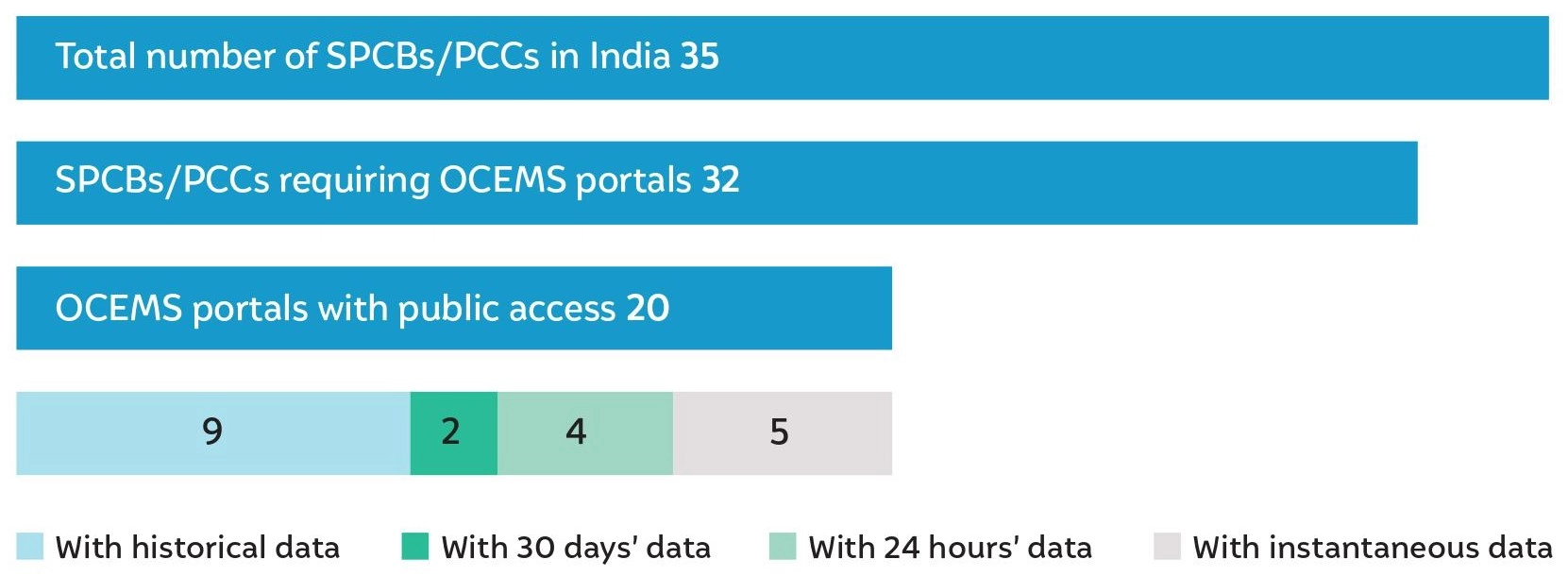
Source: Authors’ analysis
The accessible CEMS data was analysed for availability and reporting issues. The subsections below provide the highlights.
Data availability
Only six OCEMS web portals provided downloadable annual data (Assam, Chhattisgarh, Goa, Himachal Pradesh, Madhya Pradesh, and Meghalaya). Six industries were analysed (iron and steel, cement, oil refinery, petrochemicals, aluminium, and pulp and paper) with the highest emission loads in the industrial sector and found that CEMS data availability varies significantly across these six states. Data availability was calculated as a percentage of the hours in a year for which CEMS data is available — that is, the number of hours out of 8,760 hours in a year for which the CEMS relays a zero or positive value.
The CEMS data was analysed for the entire calendar years of 2019 and 2020. In general, the analysis could not account for potential disruptions or shutdown of operations at facilities because each industry type and facility would have had different inoperative periods. The average data availability would increase if those adjustments were possible. Another challenge faced was the disruption caused by the COVID-19 pandemic in 2020. Although shutdown data was not available for inclusion in the analysis, the impact on overall data availability is not expected to be significant. The industries chosen for evaluation likely continued operations through the pandemic because shutting them down would have been operationally challenging. Because there were several COVID-19-related state-wide shutdowns in 2020–21 also, CEMS data from 2019 was also analysed to assess pre-pandemic data availability. On a positive note, data availability increased in 2020 compared to 2019, despite it being a pandemic year.
Key highlights for 2020
Table ES1 Average data availability across select states and industry types (2019 and 2020)

Source: Authors’ analysis
Table ES 1 provides the estimated average data availability for the six states and six industry types for 2019 and 2020.
As per the CPCB’s clarificatory note on the Guidelines for real-time effluent and emissions data collection, every industry has to ensure 85 per cent data availability every month for all its stations and parameters (CPCB 2017b). It is challenging to evaluate and interpret these compliance criteria at monthly intervals for each stack and pollutant combination. Hence, the 85 per cent criterion was applied to the annual data for the 6 states and 6 industries to determine how many stacks complied.
Figure ES 2 shows the percentage of stacks that were in compliance in 2019 and 2020. The average compliance across all stacks was quite low at 19 and 23 per cent in 2019 and 2020, respectively. Compliance levels vary between years for a given state, but overall, compliance was mostly less than 50 per cent for all states.
Frequency of misses
Apart from the annual data availability, the frequency of missing data events was also evaluated — that is, the number of times there is a data gap in annual reporting. The Guidelines stipulate that a single missing data event should not last for more than 72 hours, and if this happens, the facility may have to stop operations. Approximately 81 and 77 per cent of the stacks had more than 1,000 hours (approximately 42 days) of missing data in 2019 and 2020, respectively. Of the 691 stacks evaluated in 2020, only 37 had zero instances of missing data events that lasted longer than 72 hours. Less than 7 per cent of the missing data events lasted more than 72 hours, but they contributed to more than 92 per cent of the total missing hours. From an enforcement perspective, targeting stacks that contribute majorly to this seven per cent can significantly increase data availability.
Parameter monitoring compliance
The CPCB mandates the specific parameters (temperature and flow rate) and pollutants that every industry needs to monitor. An analysis of pollutants and parameter monitoring compliance in 6 industry types across 6 states showed that only 65 (47 per cent) of the 134 facilities are fully compliant. Goa had no fully compliant facilities. Chhattisgarh had the greatest number of compliant facilities, but the data of only 56 facilities could be analysed; data for the remaining 43 facilities could not be downloaded. Of the rest, 15 per cent are not compliant, and 38 per cent are only partially compliant.
Ambient air quality monitoring at industrial facilities
The CPCB requires that all large and medium-sized industries located in critically polluted areas, and facilities in the 17 highly polluting industry sectors, install ambient air quality monitors (AAQMs) through a separate directive (Dube 2010).
It was found that 12 states had 527 industrial facilities with continuous ambient air quality monitors (CAAQM) for all the industry types reporting CEMS data. Several facilities also had more than one CAAQM within their premises. Data from these CAAQMs can be used to supplement the air quality data from CAAQMs utilised by the CPCB and SPCBs/PCCs that were established under the National Air Quality Monitoring Programme (NAMP) (CPCB 2022).
Figure ES2 On average, only 20% and 27% of the stacks complied with the 85% availability requirement in 2019 and 2020, respectively
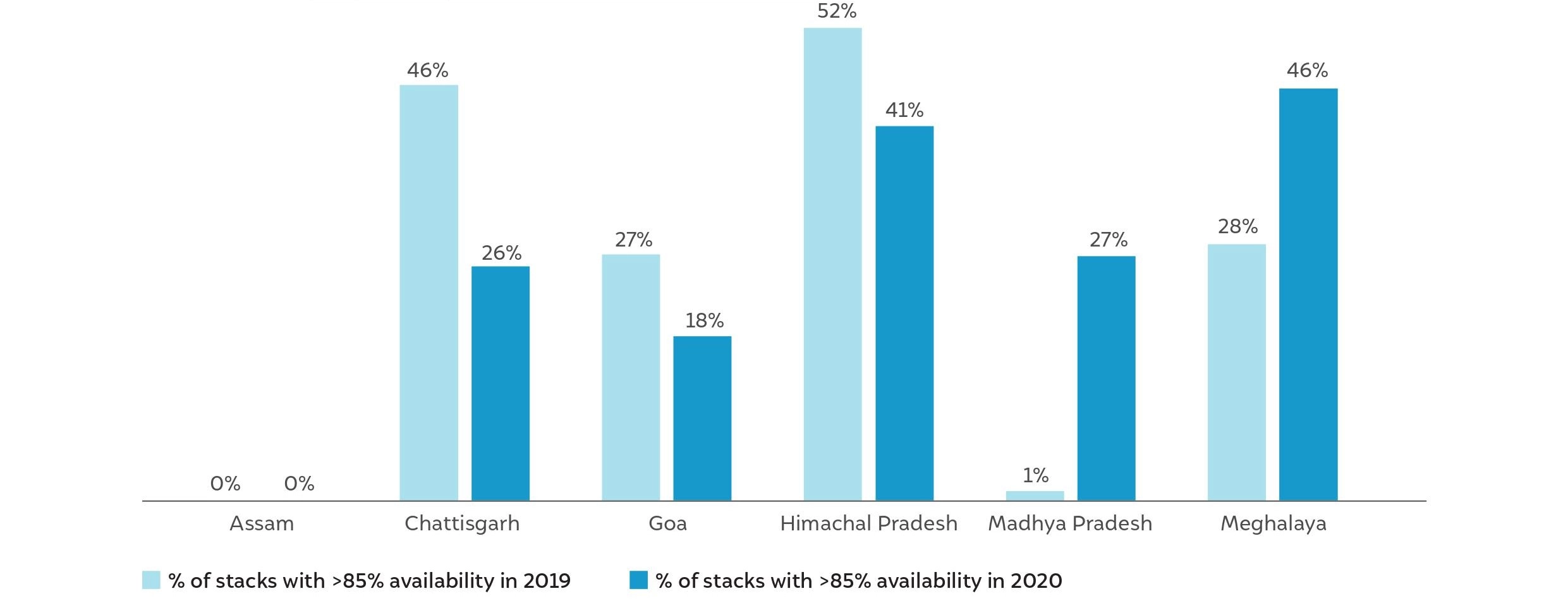
Source: Authors’ analysis
Monitoring industrial pollutants through CEMS is an important first step in mitigating emissions. However, to fulfil its purpose, data from CEMS need to be used to inform decisions related to governance and management. This requires both transparency and access to the data it generates. The following measures are recommended to make CEMS an effective tool in managing industrial air pollution.
Continuous Emission Monitoring Systems (CEMS) are devices that periodically measure the concentration and release rate of emissions from a stack, chimney or duct of an industrial facility. CEMS can measure particulates, gaseous pollutants as well as liquid pollutants.
Continuous emission monitoring works using CEMS that are selected based on the types of pollutants whose concentrations are to be captured. The CEMS consist of highly sensitive probes that are placed at a selected location along the exhaust gas system of an industrial facility. These probes periodically monitor the flow rate and concentration of various pollutants such as CO₂, CO, NOֶx, SOx, PM, etc. The captured data is relayed to processors that convert the information from the measuring device into standard units, such as normal milligram per cubic metre (mg/Nm³).
Online CEMS (OCEMS) are CEMS that relay the data to a remote server through the internet. The data is then usually displayed on a web portal that provides information related to and collected by CEMS devices across multiple stacks or chimneys associated with equipment within a facility and across multiple facilities in a given geography (typically a state). This could include emissions concentration, release rate, temperature, and calibration information.
CEMS allow collecting pollutant concentration and flow data at frequent intervals (e.g., every 15 minutes) and automatic processing and transmission of data. This greatly improves the ease, efficiency, and effectiveness of monitoring by pollution control authorities, who otherwise have to rely on manual monitoring by staff of accredited laboratories, where the frequency of checking is, at best, once a week. CEMS also substantially improve the robustness and transparency of pollution data, when installed and calibrated correctly.
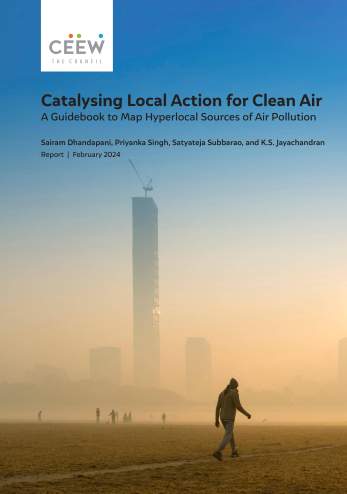
Catalysing Local Action for Clean Air
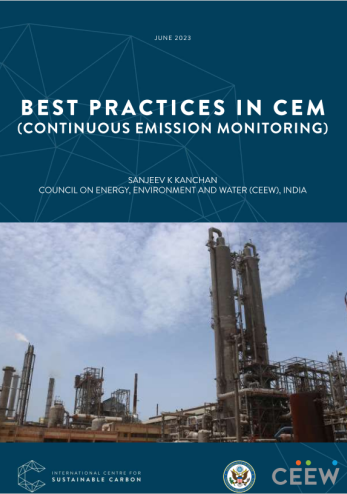
Best Practices in CEM (Continuous Emission Monitoring)
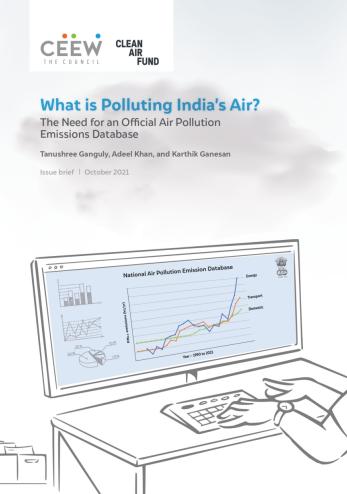
What is Polluting India’s Air? The Need for an Official Air Pollution Emissions Database
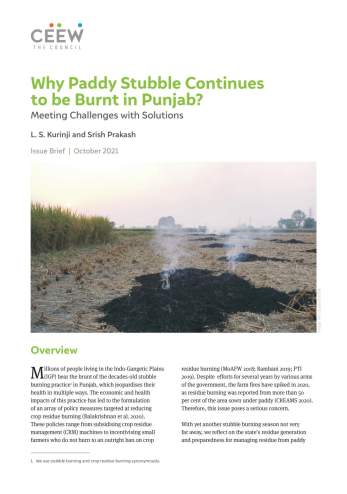
Why Paddy Stubble Continues to be Burnt in Punjab?